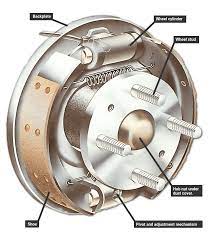It’s not always easy to know when your brake drums need replacing. But it can be an expensive mistake if you wait too long. There are a few tell-tale signs that will let you know whether or not it’s time for new brake drums, so read on to find out more!
When Do you replace brake drums
You should consider replacing your brake drums when:
- you see visible cracks on the inside or outside surface of the drum, which could mean that it has been warped by overheating;
- you notice deep grooves worn into the drum, so much so that they are visible from outside – this means it is time to replace your brake drums;
- you hear unusual squeaking noises while braking or experience strange vibrations when stopping.
- you find evidence of material transfer between the brake pads and drums where heat may have caused the lining material to come off and melt onto the drums. This means the brake material has become embedded in the drums and requires attention.
- your brakes squeal when you apply them, or when you stop at low speeds.
When replacing brake drums, you will need to replace both front and back copies of the drum if only one is worn out.
Which Is The Best Way To Ensure Longer Life Of Brake Drums?
You can avoid replacing your brake drums frequently by performing regular checks for damages as recommended by your car’s manufacturer. Also, you should inspect them more closely during regular oil changes. This way, you can save yourself from the hassle of frequent replacements and generate less waste for the environment.
There are many other tasks that should be done to ensure the long life of brake drums.
How much brake drum replacement costs?
The cost of replacing brake drums without labor will vary depending on the make and model of your vehicle. The average price range for drum replacement is around $150 to $300, plus tax. If you are looking for more accurate estimates, then you should look online or consult with an auto repair specialist in your area for specific quotes based on your needs.
Why brake drums are needed?
Brake drums are a vital component of your braking system. They house the brake shoes, which are attached to the wheel hubs via the axles. When you step on the brakes, brake fluid goes through small passages in your master cylinder that then pressurizes the lines attached to your drum brakes, causing them to expand and grip onto the inside of your brake drum. This then slows down or stops your vehicle as needed by converting kinetic energy into heat energy.
Steps to replacing brake drums:
You will need to remove your tires before replacing your brake drums. The process of removing your wheels varies depending on the make and model of your vehicle. You can either do this manually by turning the lug nuts counterclockwise with a tire iron or use an air wrench if you have one available.
- Once your wheels are off, you should see four bolts that attach your drum brakes to the axle hub assembly.
- Remove these using a ratchet and socket set; some vehicles require special tools for this purpose, so be sure to consult with an auto repair specialist beforehand if you do not own any yourself.
- Next, there is usually a spring clip holding down the brake shoe return spring on each side of the car; these clips carefully with diagonal pliers to remove, then pull up on the brake shoe return spring.
- Now you can detach your brake drum from the rest of the braking system by removing any bolts holding it in place and helping pull it out of its housing.
- You can now install your new brake drum by reversing this process, making sure to attach the drum brakes to their respective bolts with care not to strip them or over-tighten them during installation.


